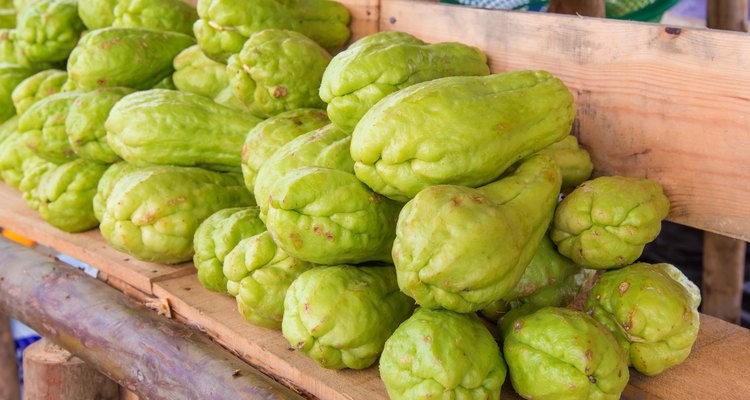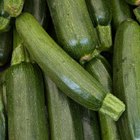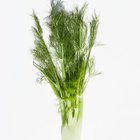
Casanowe/iStock/Getty Images
Native to Latin America, chayote squash looks like a large pear with a light green, ridged skin and white flesh. When raw, its flavor and texture is reminiscent of cucumber; when cooked, chayote alone can be rather bland with a texture of cooked zucchini. The way you chop chayote -- also called mirliton, chrisophene or choko -- depends on how you plan to use it.
Inner Seed
The squash features one soft seed. The entire chayote is edible, but the skin can be rather tough, and most recipes call for you to peel it off before chopping. You are often directed to cut around the inner seed, which has a firmer, less-pleasant texture than the outer flesh. Chayote can release a sticky sap when chopped, so you may want to wear gloves during preparation.
Slicing
Once you have peeled your chayote, cut it in half and remove the inner seed. You can then slice the flesh into any size rounds you need for your recipe. Slices measuring about 1/2 inch can be breaded and fried. You can layer 1/4-inch slices into a gratin dish and top with Parmesan, olive oil and breadcrumbs for a flavorful casserole. You could even boil slices of the squash and then quickly stir-fry with butter and fresh herbs. Use a mandoline to make the slicing process faster and to foster uniformity.
Cubing
Cubed pieces of chayote can be added to a stew or caponata. Peel the chayote and cut it in half to remove the inner seed. Cut each half into thinner slices – from 1/4 to 1/2 inch thick – and then cut them into strips. Cut the strips into cubes of relatively the same size to promote even cooking.
Grating or Julienned
For salads, julienned or grated chayote offers a textural difference that can be quite pleasing. Peel and halve the chayote to remove the seed and then use a box grater to shred the fruit. You could also julienne the squash by slicing each half into thin slices lengthwise and then chopping into thin strips. Cut these strips into 1-inch long pieces or matchsticks. You can add the julienned squash to a saute of julienned carrots and yellow squash, or saute it on its own to make a side dish.
Related Articles

Peeling the Spiny Chayote Squash
How to Boil Chayote

How to Cook a Turban Squash
How to Grill Chayote Squash

How to Julienne Jicama

How to Juice a Daikon Radish

Daisy’s Guacamole Recipe

How to Eat a Kiwano Horned Melon

How to Tell When Okra Is Ripe

How to Cook Manioc Root

How to Cook Jerusalem Artichokes

How to Cook Papaya

How to Eat Kohlrabi

How Do I Reduce the Slime When Cooking ...

How to Blanch Cucumbers

Differences in Acorn & Butternut Squash

How to Clean Zucchini

Calories in a Large Zucchini

How to Julienne Fennel

Can You Eat Raw Artichokes?
References
Writer Bio
Andrea Boldt has been in the fitness industry for more than 20 years. A personal trainer, run coach, group fitness instructor and master yoga teacher, she also holds certifications in holistic and fitness nutrition.
Photo Credits
Casanowe/iStock/Getty Images